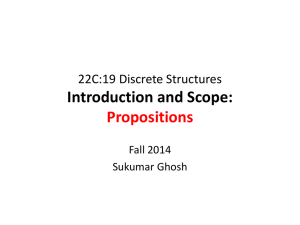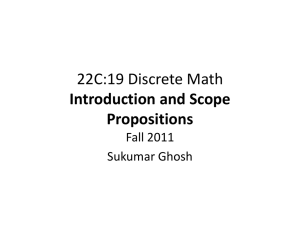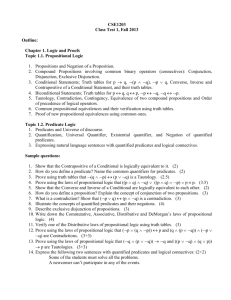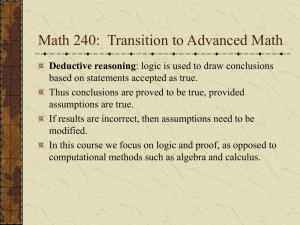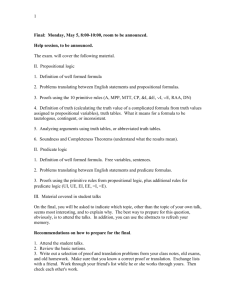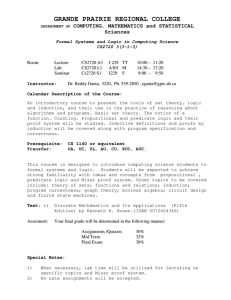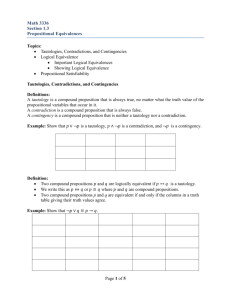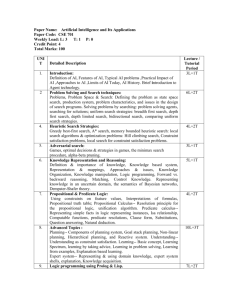Module #1: The Fundamentals of Logic
advertisement
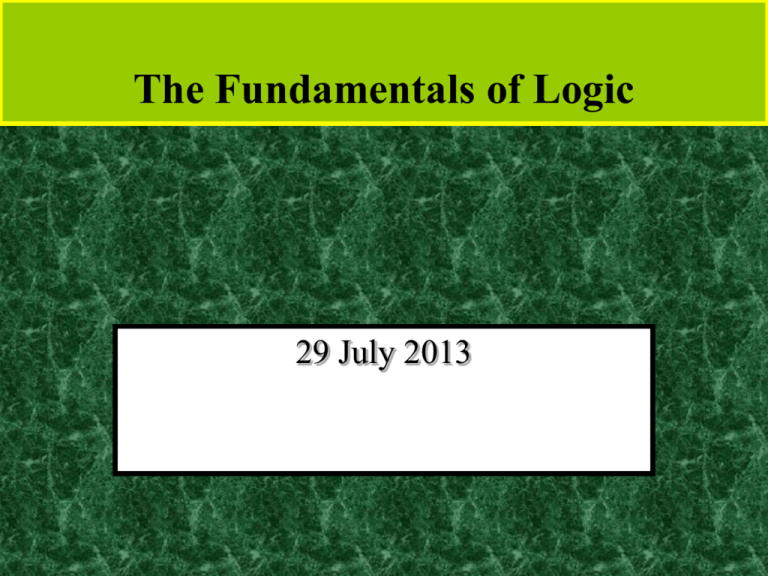
Module #1 - Logic The Fundamentals of Logic 29 July 2013 Module #1 - Logic Foundations of Logic Mathematical Logic is a tool for working with elaborate compound statements. It includes: • A formal language for expressing them. • A concise notation for writing them. • A methodology for objectively reasoning about their truth or falsity. • It is the foundation for expressing formal proofs in all branches of mathematics. Module #1 - Logic Foundations of Logic: Overview • Propositional logic (§1.1-1.2): – Basic definitions. (§1.1) – Equivalence rules & derivations. (§1.2) • Predicate logic (§1.3-1.4) – Predicates. – Quantified predicate expressions. – Equivalences & derivations. Module #1 - Logic Topic #1 – Propositional Logic Propositional Logic (§1.1) Propositional Logic is the logic of compound statements built from simpler statements using so-called Boolean connectives. Some applications in computer science: • Design of digital electronic circuits. • Expressing conditions in programs. • Queries to databases & search engines. George Boole (1815-1864) Chrysippus of Soli (ca. 281 B.C. – 205 B.C.) Module #1 - Logic Topic #1 – Propositional Logic Definition of a Proposition Definition: A proposition (denoted p, q, r, …) is simply: • a statement (i.e., a declarative sentence) – with some definite meaning, (not vague or ambiguous) • having a truth value that’s either true (T) or false (F) – it is never both, neither, or somewhere “in between!” • However, you might not know the actual truth value, • and, the truth value might depend on the situation or context. • Later, we will study probability theory, in which we assign degrees of certainty (“between” T and F) to propositions. – But for now: think True/False only! Module #1 - Logic Topic #1 – Propositional Logic Examples of Propositions • “It is raining.” (In a given situation.) • “Beijing is the capital of China.” • “1 + 2 = 3” But, the following are NOT propositions: • “Who’s there?” (interrogative, question) • “La la la la la.” (meaningless interjection) • “Just do it!” (imperative, command) • “Yeah, I sorta dunno, whatever...” (vague) • “1 + 2” (expression with a non-true/false value) Module #1 - Logic Topic #1.0 – Propositional Logic: Operators Operators / Connectives An operator or connective combines one or more operand expressions into a larger expression. (E.g., “+” in numeric exprs.) • Unary operators take 1 operand (e.g., −3); binary operators take 2 operands (eg 3 4). • Propositional or Boolean operators operate on propositions (or their truth values) instead of on numbers. Module #1 - Logic Topic #1.0 – Propositional Logic: Operators Some Popular Boolean Operators Formal Name Nickname Arity Symbol Negation operator NOT Unary ¬ Conjunction operator AND Binary Disjunction operator OR Binary Exclusive-OR operator XOR Binary Implication operator IMPLIES Binary Biconditional operator IFF Binary ↔ Module #1 - Logic Topic #1.0 – Propositional Logic: Operators The Negation Operator The unary negation operator “¬” (NOT) transforms a prop. into its logical negation. E.g. If p = “I have brown hair.” then ¬p = “I do not have brown hair.” p p The truth table for NOT: T F T :≡ True; F :≡ False F T “:≡” means “is defined as” Operand column Result column Module #1 - Logic Topic #1.0 – Propositional Logic: Operators The Conjunction Operator The binary conjunction operator “” (AND) combines two propositions to form their ND logical conjunction. E.g. If p=“I will have salad for lunch.” and q=“I will have steak for dinner.”, then pq=“I will have salad for lunch and I will have steak for dinner.” Remember: “” points up like an “A”, and it means “ND” Module #1 - Logic Topic #1.0 – Propositional Logic: Operators Conjunction Truth Table Operand columns • Note that a p q pq conjunction F F F p1 p2 … pn F T F of n propositions T F F will have 2n rows in its truth table. T T T • Also: ¬ and operations together are sufficient to express any Boolean truth table! Module #1 - Logic Topic #1.0 – Propositional Logic: Operators The Disjunction Operator The binary disjunction operator “” (OR) combines two propositions to form their logical disjunction. p=“My car has a bad engine.” q=“My car has a bad carburetor.” pq=“Either my car has a bad engine, or the downwardmy car has a bad carburetor.” After pointing “axe” of “” Meaning is like “and/or” in English. splits the wood, you can take 1 piece OR the other, or both. Module #1 - Logic Topic #1.0 – Propositional Logic: Operators Disjunction Truth Table • Note that pq means p q pq that p is true, or q is F F F true, or both are true! Note F T T difference • So, this operation is T F T from AND also called inclusive or, T T T because it includes the possibility that both p and q are true. • “¬” and “” together are also universal. Module #1 - Logic Topic #1.0 – Propositional Logic: Operators Nested Propositional Expressions • Use parentheses to group sub-expressions: “I just saw my old friend, and either he’s grown or I’ve shrunk.” = f (g s) – (f g) s would mean something different – f g s would be ambiguous • By convention, “¬” takes precedence over both “” and “”. – ¬s f means (¬s) f , not ¬ (s f) Module #1 - Logic Topic #1.0 – Propositional Logic: Operators A Simple Exercise Let p=“It rained last night”, q=“The sprinklers came on last night,” r=“The lawn was wet this morning.” Translate each of the following into English: ¬p = “It didn’t rain last night.” lawn was wet this morning, and r ¬p = “The it didn’t rain last night.” ¬ r p q = “Either the lawn wasn’t wet this morning, or it rained last night, or the sprinklers came on last night.” Module #1 - Logic Topic #1.0 – Propositional Logic: Operators The Exclusive Or Operator The binary exclusive-or operator “” (XOR) combines two propositions to form their logical “exclusive or” (exjunction?). p = “I will earn an A in this course,” q = “I will drop this course,” p q = “I will either earn an A in this course, or I will drop it (but not both!)” Module #1 - Logic Topic #1.0 – Propositional Logic: Operators Exclusive-Or Truth Table • Note that pq means p q pq that p is true, or q is F F F true, but not both! F T T • This operation is T F T called exclusive or, T T F because it excludes the possibility that both p and q are true. • “¬” and “” together are not universal. Note difference from OR. Module #1 - Logic Topic #1.0 – Propositional Logic: Operators Natural Language is Ambiguous Note that English “or” can be ambiguous regarding the “both” case! p q p "or" q “Pat is a singer or F F F Pat is a writer.” - F T T “Pat is a man or T F T Pat is a woman.” - T T ? Need context to disambiguate the meaning! For this class, assume “or” means inclusive. Topic #1.0 – Propositional Logic: Operators Module #1 - Logic The Implication Operator antecedent consequent The implication p q states that p implies q. I.e., If p is true, then q is true; but if p is not true, then q could be either true or false. E.g., let p = “You study hard.” q = “You will get a good grade.” p q = “If you study hard, then you will get a good grade.” (else, it could go either way) Module #1 - Logic Topic #1.0 – Propositional Logic: Operators Implication Truth Table • p q is false only when p q pq p is true but q is not true. F F T • p q does not say F T T that p causes q! T F F • p q does not require T T T that p or q are ever true! • E.g. “(1=0) pigs can fly” is TRUE! The only False case! Module #1 - Logic Topic #1.0 – Propositional Logic: Operators Examples of Implications • “If this lecture ever ends, then the sun will rise tomorrow.” True or False? • “If Tuesday is a day of the week, then I am a penguin.” True or False? • “If 1+1=6, then Bush is president.” True or False? • “If the moon is made of green cheese, then I am richer than Bill Gates.” True or False? Module #1 - Logic Why does this seem wrong? • Consider a sentence like, – “If I wear a red shirt tomorrow, then Osama bin Laden will be captured!” • In logic, we consider the sentence True so long as either I don’t wear a red shirt, or Osama is caught. • But, in normal English conversation, if I were to make this claim, you would think that I was lying. – Why this discrepancy between logic & language? Module #1 - Logic Resolving the Discrepancy • In English, a sentence “if p then q” usually really implicitly means something like, – “In all possible situations, if p then q.” • That is, “For p to be true and q false is impossible.” • Or, “I guarantee that no matter what, if p, then q.” • This can be expressed in predicate logic as: – “For all situations s, if p is true in situation s, then q is also true in situation s” – Formally, we could write: s, P(s) → Q(s) • That sentence is logically False in our example, because for me to wear a red shirt and for Osama to stay free is a possible (even if not actual) situation. – Natural language and logic then agree with each other. Module #1 - Logic Topic #1.0 – Propositional Logic: Operators English Phrases Meaning p q • • • • • • • • “p implies q” “if p, then q” “if p, q” “when p, q” “whenever p, q” “q if p” “q when p” “q whenever p” • • • • • “p only if q” “p is sufficient for q” “q is necessary for p” “q follows from p” “q is implied by p” We will see some equivalent logic expressions later. Module #1 - Logic Topic #1.0 – Propositional Logic: Operators Converse, Inverse, Contrapositive Some terminology, for an implication p q: • Its converse is: q p. • Its inverse is: ¬p ¬q. • Its contrapositive: ¬q ¬ p. • One of these three has the same meaning (same truth table) as p q. Can you figure out which? Topic #1.0 – Propositional Logic: Operators Module #1 - Logic How do we know for sure? Proving the equivalence of p q and its contrapositive using truth tables: p F F T T q F T F T q T F T F p T T F F pq q p T T T T F F T T Topic #1.0 – Propositional Logic: Operators Module #1 - Logic The biconditional operator The biconditional p q states that p is true if and only if (IFF) q is true. p = “Bush wins the 2004 election.” q = “Bush will be president for all of 2005.” p q = “If, and only if, Bush wins the 2004 election, Bush will be president for all of 2005.” 2004 2005 I’m still here! Module #1 - Logic Topic #1.0 – Propositional Logic: Operators Biconditional Truth Table • p q means that p and q have the same truth value. • Note this truth table is the exact opposite of ’s! Thus, p q means ¬(p q) p F F T T q pq F T T F F F T T • p q does not imply that p and q are true, or that either of them causes the other, or that they have a common cause. Module #1 - Logic Topic #1.0 – Propositional Logic: Operators Boolean Operations Summary • We have seen 1 unary operator (out of the 4 possible) and 5 binary operators (out of the 16 possible). Their truth tables are below. p F F T T q F T F T p pq pq pq pq pq T F F F T T T F T T T F F F T T F F F T T F T T Module #1 - Logic Topic #1.0 – Propositional Logic: Operators Some Alternative Notations Name: Propositional logic: Boolean algebra: C/C++/Java (wordwise): C/C++/Java (bitwise): Logic gates: not and or p pq + ! && || ~ & | xor implies != ^ iff == Module #1 - Logic Topic #2 – Bits Bits and Bit Operations John Tukey • A bit is a binary (base 2) digit: 0 or 1. (1915-2000) • Bits may be used to represent truth values. • By convention: 0 represents “false”; 1 represents “true”. • Boolean algebra is like ordinary algebra except that variables stand for bits, + means “or”, and multiplication means “and”. – See module 23 (chapter 10) for more details. Topic #2 – Bits Module #1 - Logic Bit Strings • A Bit string of length n is an ordered sequence (series, tuple) of n0 bits. – More on sequences in §3.2. • By convention, bit strings are (sometimes) written left to right: – e.g. the “first” bit of the bit string “1001101010” is 1. – Watch out! Another common convention is that the rightmost bit is bit #0, the 2nd-rightmost is bit #1, etc. • When a bit string represents a base-2 number, by convention, the first (leftmost) bit is the most significant bit. Ex. 11012=8+4+1=13. Topic #2 – Bits Module #1 - Logic Counting in Binary • Did you know that you can count to 1,023 just using two hands? – How? Count in binary! • Each finger (up/down) represents 1 bit. • To increment: Flip the rightmost (low-order) bit. – If it changes 1→0, then also flip the next bit to the left, • If that bit changes 1→0, then flip the next one, etc. • 0000000000, 0000000001, 0000000010, … …, 1111111101, 1111111110, 1111111111 Topic #2 – Bits Module #1 - Logic Bitwise Operations • Boolean operations can be extended to operate on bit strings as well as single bits. • E.g.: 01 1011 0110 11 0001 1101 11 1011 1111 Bit-wise OR 01 0001 0100 Bit-wise AND 10 1010 1011 Bit-wise XOR Module #1 - Logic End of §1.1 You have learned about: • Propositions: What they are. • Propositional logic operators’ – – – – Symbolic notations. English equivalents. Logical meaning. Truth tables. • Atomic vs. compound propositions. • Alternative notations. • Bits and bit-strings. • Next section: §1.2 – Propositional equivalences. – How to prove them. Module #1 - Logic Topic #1.1 – Propositional Logic: Equivalences Propositional Equivalence (§1.2) Two syntactically (i.e., textually) different compound propositions may be the semantically identical (i.e., have the same meaning). We call them equivalent. Learn: • Various equivalence rules or laws. • How to prove equivalences using symbolic derivations. Module #1 - Logic Topic #1.1 – Propositional Logic: Equivalences Tautologies and Contradictions A tautology is a compound proposition that is true no matter what the truth values of its atomic propositions are! Ex. p p [What is its truth table?] A contradiction is a compound proposition that is false no matter what! Ex. p p [Truth table?] Other compound props. are contingencies. Module #1 - Logic Topic #1.1 – Propositional Logic: Equivalences Logical Equivalence Compound proposition p is logically equivalent to compound proposition q, written pq, IFF the compound proposition pq is a tautology. Compound propositions p and q are logically equivalent to each other IFF p and q contain the same truth values as each other in all rows of their truth tables. Topic #1.1 – Propositional Logic: Equivalences Module #1 - Logic Proving Equivalence via Truth Tables Ex. Prove that pq (p q). p F F T T q F T F T pq F T T T p T T F F q p q (p q) T T F F F T T F T F F T Module #1 - Logic Topic #1.1 – Propositional Logic: Equivalences Equivalence Laws • These are similar to the arithmetic identities you may have learned in algebra, but for propositional equivalences instead. • They provide a pattern or template that can be used to match all or part of a much more complicated proposition and to find an equivalence for it. Module #1 - Logic Topic #1.1 – Propositional Logic: Equivalences Equivalence Laws - Examples • • • • • • Identity: pT p pF p Domination: pT T pF F Idempotent: pp p pp p Double negation: p p Commutative: pq qp pq qp Associative: (pq)r p(qr) (pq)r p(qr) Module #1 - Logic Topic #1.1 – Propositional Logic: Equivalences More Equivalence Laws • Distributive: p(qr) (pq)(pr) p(qr) (pq)(pr) • De Morgan’s: (pq) p q (pq) p q • Trivial tautology/contradiction: p p T p p F Augustus De Morgan (1806-1871) Module #1 - Logic Topic #1.1 – Propositional Logic: Equivalences Defining Operators via Equivalences Using equivalences, we can define operators in terms of other operators. • Exclusive or: pq (pq)(pq) pq (pq)(qp) • Implies: pq p q • Biconditional: pq (pq) (qp) pq (pq) Module #1 - Logic Topic #1.1 – Propositional Logic: Equivalences An Example Problem • Check using a symbolic derivation whether (p q) (p r) p q r. (p q) (p r) [Expand definition of ] (p q) (p r) [Expand defn. of ] (p q) ((p r) (p r)) [DeMorgan’s Law] (p q) ((p r) (p r)) cont. Module #1 - Logic Topic #1.1 – Propositional Logic: Equivalences Example Continued... (p q) ((p r) (p r)) [ commutes] (q p) ((p r) (p r)) [ associative] q (p ((p r) (p r))) [distrib. over ] q (((p (p r)) (p (p r))) [assoc.] q (((p p) r) (p (p r))) [trivail taut.] q ((T r) (p (p r))) [domination] q (T (p (p r))) [identity] q (p (p r)) cont. Module #1 - Logic Topic #1.1 – Propositional Logic: Equivalences End of Long Example q (p (p r)) [DeMorgan’s] q (p (p r)) [Assoc.] q ((p p) r) [Idempotent] q (p r) [Assoc.] (q p) r [Commut.] p q r Q.E.D. (quod erat demonstrandum) (Which was to be shown.) Module #1 - Logic Topic #1 – Propositional Logic Review: Propositional Logic (§§1.1-1.2) • • • • • Atomic propositions: p, q, r, … Boolean operators: Compound propositions: s : (p q) r Equivalences: pq (p q) Proving equivalences using: – Truth tables. – Symbolic derivations. p q r … Module #1 - Logic Formal Theory for Prop. Logic Axioms A1: A 2C)) C)) A3: (B A) ((B A) B) Inference rule (modus ponens) A (A B) B Module #1 - Logic An Example • A is a theorem • (Proof) (A A ) ((A A)) A (axiom A2) (A A ) (axiom A1) ((A A)) A (1, 2, & MP) (A A)) (axiom A1) A 3,4&MP
